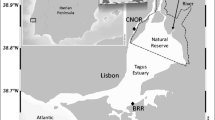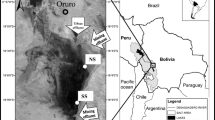Abstract
Model aquatic ecosystems have been used to study the natural mechanisms involved in the distribution and transformation of inorganic mercury (IHg) in the different compartments and its interactions with the biota. Laboratory incubations in indoor freshwater microcosms, presenting a simple biological organization, were carried out at various spiked concentrations (3, 25 and 257 nmol l−1 of IHg, as mercuric chloride) and from a single initial contamination of the water column. The different compartments of the model ecosystems (water, sediment, macrophytes Elodea canadensis and snails Lymnaea stagnalis) were investigated for mercury distribution and speciation during a 2-month experimental period. The principal results obtained have evidenced different Hg biogeochemical pathways including biotic IHg methylation and reduction and transfer to the biota. A fast transfer of IHg from the water to the aquatic organisms and to the sediment was first observed with IHg half-lives of 24 h and 8 days, respectively. IHg methylation, clearly related to biogenic processes, was also demonstrated in all contaminated microcosms after 1 week of exposure. Finally, gaseous mercury species were determined in the different microcosms and significant biological induced production of elemental Hg (Hg°) and dimethyl Hg (DMHg) was observed. This overall investigation, based on the time courses evolution of IHg and in situ produced monomethylmercury (MMHg) concentrations allows to determine uptake and elimination rate constants for IHg as well as the bioaccumulation kinetics of MMHg in macrophytes and snails. The applicability of these aquatic model ecosystems to provide real insights for pollution impact and ecotoxicological risk assessments has been demonstrated.





Similar content being viewed by others
References
Amouroux, D., Tessier, E., Pécheyran, C., & Donard, O. F. X. (1998). Sampling and probing volatile metal(loid) compounds in natural waters by in-situ purge and cryogenic trapping followed by gas chromatography and inductively coupled plasma mass spectrometry (P-CT-GC-ICP/MS). Analytica Chimica Acta, 377, 241–254.
Andersson, I., Parkman, H., & Jernelov, A. (1990). The role of sediments as sink or source for environmental contaminants: A case study of mercury and chlorinatedorganic compounds. Limnologica, 20, 475–489.
Barron, M. G., Stehly, G. R., & Hayton, W. L. (1990). Pharmacokinetic modeling in aquatic animals I. Models and concepts. Aquatic Toxicology, 18, 61–85.
Benoit, J. M., Gilmour, C. C., Heyes, A., Mason, R. P., & Miller, C. L. (2003). Geochemical and biological controls over methylmercury production and degradation in aquatic ecosystems. In Y. Cai & O. C. Braids (Eds.), Biogeochemistry of environmentally important trace elements (pp. 262–297). Washington: ACS.
Bloom, N. S. (1989). Determination of picogram levels of methylmercury by aqueous phase ethylation, followed by cryogenic gas chomatography with cold vapour atomic fluorescence detection. Canadian Journal of Fisheries and Aquatic Sciences, 46, 1131–1140.
Boudou, A., & Ribeyre, F. (1997). Mercury in the food webs: Accumulation and transfer mechanisms. Metal Ions in Biological Systems, 34, 289–319.
Compeau, C. G., & Bartha, R. (1985). Sulfate-reducing bacteria: Principal methylators of mercury in anoxic estuarine sediment. Applied Environmental Microbiology, 50, 498–502.
Everard, M., & Denny, P. (1985). Flux of lead in submerged plants and its relevance to a freshwater system. Aquatic Botany, 21, 181–193.
Gilmour, C. C., Riedel, G. S., Ederington, M. C., Bell, J. T., Benoit, J. M., Gill, G. A., et al. (1998). Methylmercury concentrations and production rates across a trophic gradient in the northern Everglades. Biogeochemistry, 40, 327–345.
Horvat, M. (1996). Mercury analysis and specification in environmental samples. In W. Baeyens, R. Ebinghaus, & O. Vasiliev (Eds.), Global and regional mercury cycles: Sources, fluxes and mass balances (pp. 1–31). Dordrecht, Netherlands: Kluwer.
International Organization for Standardization (1996). Water quality – Determination of the inhibition of the mobility of Daphnia magna Straus (Cladocera, Crustacea) – Acute toxicity test. ISO 6341: 1996.
Jensen, S., & Jernelov, A. (1969). Biological methylation of mercury in aquatic organisms. Nature, 223, 753–754.
Kähkönen, M. A., & Manninen, P. K. G. (1998). The uptake of nickel and chromium from water by Elodea canadensis at different nickel and chromium exposure levels. Chemosphere, 36, 1381–1390.
Korthals, C. G., & Winfrey, M. R. (1987). Seasonal and spatial variations in mercury methylation and demethylation in an oligotrophic lake. Applied Environmental Microbiology, 53, 2397–2404.
Krabbenhoft, D. P., Hurley, J. P., Olson, M. L., & Cleckne, L. B. (1998). Diel variability of mercury phase and species distributions in the Florida Everglades. Biogeochemistry, 40, 311–325.
Lindqvist, O. (1991). Mercury in the Swedish environment. Recent research on causes, consequences and corrective measures. Water Air Soil Pollution, 55, 1–261.
Lindström, M. (2001). Distribution of particulate and reactive mercury in surface waters of Swedish forest lakes: An empirically based predictive model. Ecological. Modelling, 136, 81–93.
Lyon, B. F., Ambrose, R., Rice, G., & Maxwell, C. J. (1997). Calculation of soil-water and benthic sediment partition coefficients for mercury. Chemosphere, 35, 791–808.
Mal, T. K., Adorjan, P., & Corbett, A. L. (2002). Effect of Copper on the growth of an aquatic macrophyte, Elodea canadensis. Environmental Pollution, 120, 307–311.
Mason, R. P., Reinfelder, J. R., & Morel, F. M. M. (1996). Uptake, toxicity, and trophic transfer of mercury in a coastal diatom. Environmental Science and Technology, 30, 1835–1845.
Mauro, J. B. N., Guimaraes, J. R. D., Hintelmann, H., Watras, C. J., Haack, E. A., & Coelho-Souza, S. A. (2002). Mercury methylation in macrophytes, periphyton and water: Comparative studies with stable and radio-mercury additions. Analytical Bioanalytical Chemistry, 374, 983–989.
Meili, M. (1997). Mercury in rivers and lakes. Metal Ions in Biological Systems, 34, 21–51.
Montgomery, S., Lucotte, M., & Rheault, I. (2000). Temporal and spatial influences of flooding on dissolved mercury in boreal reservoirs. Science of the Total Environment, 260, 147–157.
Morel, F. M. M., & Hering, J. G. (1993). Principles and applications of aquatic chemistry. New York: Wiley.
Morel, F. M. M., Kraepiel, A. M. L., & Amoyt, M. (1998). The chemical cycle and bioaccumulation of mercury. Annual Review of Ecology and Systematics, 29, 543–566.
O’Driscoll, N. J., Beauchamp, S., Siciliano, S. D., Rencz, A. N., & Lean, D. R. S. (2003). Continuous analysis of dissolved gaseous mercury (DGM) and mercury flux in two freshwater lakes in Kejimkujik Park, Nova Scotia: Evaluating mercury flux models with quantitative data. Environmental Science and Technology, 37, 2226–2235.
Olson, B. H., & Cooper, R. C. (1974). In situ methylation of mercury by estuarine sediment. Nature, 252, 682–684.
Pécheyran, C., Quetel, C. R., Martin, F., & Donard, O. F. X. (1998). Simultaneous determination of volatile metal (Pb,Hg, Sn, In, Ga) and nonmetal species (Se, P, As) in different atmospheres by cryofocusing and detection by ICP-MS. Analytical Chemistry, 70, 2639–2645.
Pieczynska, E. (2003). Effect of damage by the snail Lymnaea (Lymnaea) stagnalis (L.) on the growth of Elodea canadensis Michx. Aquatic Botany, 75, 137–145.
Poissant, L., Amyot, M., Pilote, M., & Lean, D. (2000). Mercury water-air exchange over the Upper St. Lawrence River and Lake Ontario. Environmental Science and Technology, 34, 3069–3078.
Porcella, D. B. (1994). Mercury in the environment: Biogeochemistry. In C. J. Watras & J. W. Huckabee (Eds.), Mercury pollution: Integration and synthesis (pp. 3–19). Boca Raton, FL: Lewis.
Pritchard, P. H., Monti, C. A., O’Neill, E. J., Conndly, J. P., & Ahearn, D. G. (1986). Movement of kepone (chlordecone) across an undisturbed sediment-water interface in laboratory systems. Environmental Toxicology and Chemistry, 5, 647–657.
Ribeyre, F., & Boudou, A. (1989). Trophic chains and experimental ecosystems: Study of bioaccumulation and transfer processes. In A. Boudou & F. Ribeyre (Eds.), Aquatic ecotoxicology: Fundamental concepts and methodologies (Vol. II) (pp. 3–46). Boca Raton, FL: CRC Press.
Ribeyre, F., & Boudou, A. (1994). Experimental study of inorganic and methylmercury bioaccumulation by 4 species of fresh-water rooted macrophytes from water and sediment contamination sources. Ecotoxicology and Environmental Safety, 28, 270–286.
RIVM (1995). Integrated criteria document mercury. W. Slooff, P. Van Beelen, J. A. Annema & J. A. Janus (Eds.), Report no. 601014008.
Robinson, J. B., & Tuovinen, O. H. (1984). Mechanism of microbial resistance and detoxofication of mercury and organomercury compounds: Physiological, biochemical and genetic analysis. Microbiology Reviews, 48, 95–124.
Rodriguez Martin-Doimeadios, R. C., Tessier, E., Amouroux, D., Guyoneaud, R., Duran, R., Caumette, P., et al. (2004). Mercury methylation/demethylation and volatilization pathways in estuarine sediment slurries using species-specific enriched stable isotopes. Marine Chemistry, 90, 107–123.
Roulet, M., Lucotte, M., Guimaraes, J. R. D., & Rheault, I. (2000). Methylmercury in water, seston, and epiphyton of an Amazonian river and its floodplain, Tapajós River, Brazil. Science of the Total Environment, 261, 43–59.
Siciliano, S. D., O’Driscoll, N. J., & Lean, D. R. S. (2003). Dissolved gaseous mercury profiles in freshwaters. In Y. Cai & O. C. Braids (Eds.), Biogeochemistry of environmentally important trace elements (pp. 232–245). Washington: ACS.
Simon, O., & Boudou, A. (2001). Direct and trophic contamination of the herbivorous carp by inorganic mercury and methylmercury. Ecotoxicology and Environmental Safety, 50, 48–59.
Stein, E. D., Chen, Y., & Winer, A. M. (1996). Environmental distribution and transformation of mercury compounds. Critical Reviews in Environmental Science and Technology, 26, 1–43.
Stoichev, T., Rodriguez Martin-Doimeadios, R. C., Amouroux, D., Molenat, N., & Donard, O. F. X. (2002). Application of cryofocusing hydride generation and atomic fluorescence detection for dissolved mercury species determination in natural water samples. Journal of Environmental Monitoring, 4, 517–521.
Stoichev, T., Rodriguez Martin-Doimeadios, R. C., Tessier, E., Amouroux, D., & Donard, O. F. X. (2004). Improvement of analytical performances for mercury speciation by on-line derivatization, cryofocussing and atomic fluorescence spectrometry. Talanta, 62, 433–438.
Stumm, W., & Morgan, J. J. (1996). Aquatic chemistry – Chemical equilibria and rates in natural waters (3rd Ed.). New York: Wiley.
Taub, F. B. (1989). Standardized aquatic microcosm-development and testing. In A. Boudou & F. Ribeyre (Eds.), Aquatic ecotoxicology: Fundamental concepts and methodologies (Vol II) (pp. 47–92). Boca Raton, FL: CRC Press.
Tessier, E., Amouroux, D., & Donard, O. F. X. (2003). Biogenic volatilization of trace elements from European estuaries. In Y. Cai & O. C. Braids (Eds.), Biogeochemistry of environmentally important trace elements (pp. 151–165). Washington: ACS.
Tseng, C. M., Amouroux, D., Abril, G., Tessier, E., Etcheber, H., & Donard, O. F. X. (2001). Speciation of mercury in a fluid mud profile of a highly turbid macrotidal estuary (Gironde, France). Environmental Science and Technology, 35, 2627–2633.
Tseng, C. M., De Diego, A., Pinaly, H., Amouroux, D., & Donard, O. F. X. (1998). Cryofocusing coupled to atomic absorption for rapid and simple mercury speciation in environmental matrices. Journal of Analytical Atomic Spectrometry, 13, 755–764.
Vandal, G. M., Mason, R. P., & Fitzgerald, W. F. (1991). Cycling of volatile mercury in temperate lakes. Water, Air and Soil Pollution, 56, 791–803.
Watras, C. J., Back, R. C., Halvorsen, S., Hudson, R. J. M., Morrison, K. A., & Wente, S. P. (1998). Bioaccumulation of mercury in pelagic freshwater food webs. Science of the Total Environment, 219, 183–208.
Xun, L., Campbell, N. E. R., & Rudd, J. W. M. (1987). Measurements of specific rates of net methyl mercury production in the water column and surface sediments of acidified and circumneutral lakes. Canadian Journal of Fisheries and Aquatic Sciences, 44, 750–757.
Acknowledgments
R.C. Rodriguez Martin-Doimeadios thanks the European Union for her post-doctoral Marie-Curie grant (HPMF-CT-1999-00244). E. Tessier acknowledges the Institut National de l’Environnement Industriel et des Risques (INERIS, Dpt. Risques Chroniques) for his Ph.D. grant.
Author information
Authors and Affiliations
Corresponding author
Additional information
Rosa C. Rodriguez Martin-Doimeadios is on leave from the Department of Analytical Chemistry and Food Technology, University of Castilla-La Mancha, Faculty of Environmental Sciences, Toledo, Spain.
Rights and permissions
About this article
Cite this article
Tessier, E., Rodriguez Martin-Doimeadios, R.C., Amouroux, D. et al. Time Course Transformations and Fate of Mercury in Aquatic Model Ecosystems. Water Air Soil Pollut 183, 265–281 (2007). https://doi.org/10.1007/s11270-007-9375-3
Received:
Accepted:
Published:
Issue Date:
DOI: https://doi.org/10.1007/s11270-007-9375-3




